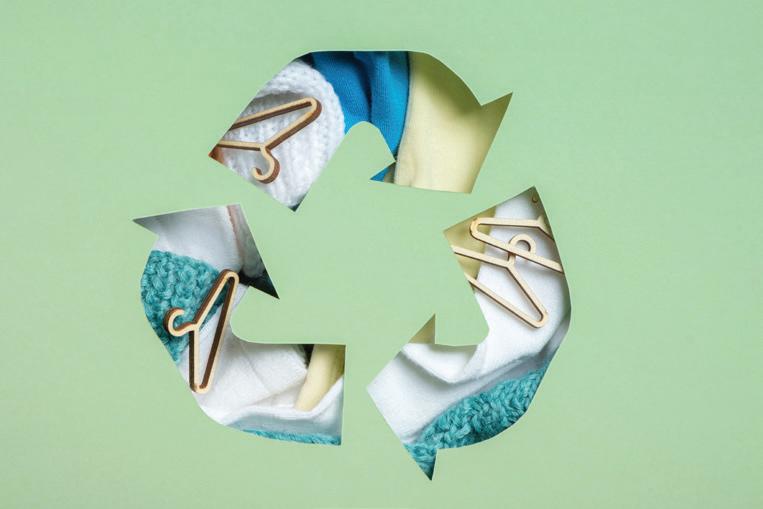
3 minute read
Wardrobe
CREATING A SUSTAINABLE WARDROBE IS BECOMING AN INCREASINGLY POPULAR CHOICE AMONG CONSCIOUS CONSUMERS WHO WANT TO TAKE RESPONSIBILITY FOR THEIR ENVIRONMENTAL IMPACT. A SUSTAINABLE WARDROBE ISN'T JUST ABOUT BUYING CLOTHES THAT ARE ECO-FRIENDLY; IT'S ALSO ABOUT MAKING SMART CHOICES WHEN PURCHASING AND CARING FOR YOUR CLOTHING, SO YOU CAN REDUCE THE AMOUNT OF WASTE YOU CREATE OVERALL. THIS ARTICLE WILL EXPLORE HOW TO CREATE AND MAINTAIN A SUSTAINABLE WARDROBE IN MULTIPLE DIFFERENT WAYS; FROM REPAIRING DAMAGED CLOTHING, IF POSSIBLE, TO BUYING QUALITY CLOTHING MADE TO LAST. YOU DON'T HAVE TO COMPROMISE ON STYLE TO HELP REDUCE YOUR ENVIRONMENTAL IMPACT!
Buy Quality Clothing Made To Last
Advertisement
Buying quality clothing that is made to last is much more eco-friendly than cheap clothes that wear out fast. This practice eliminates the need for constant replacements, which reduces the amount of waste you're creating in the long run. While purchasing qual- ity items is more expensive initially, buying high quality items saves money in the long run. When high-quality pieces eventually do reach the end of their life cycle, they can be donated or re-purposed for fabric instead of thrown away—options that are not possible with cheaper alternatives. When cheaper alternatives wear out, there's nothing else you can do but trash them. Buying quality clothing that is designed to last not only saves money but also helps protect our environment by reducing unnecessary waste production and consumption of resources.
Repair Damaged Clothing That You Already Own
Repairing any damaged clothing you already have, if possible, is an important part of the sustainability movement. It eliminates the need to buy new items, which can be expensive and wasteful in terms of resources used to manufacture them. Not only that, but repairing existing garments also reduces their individual environmental impact because you're extending their life. A whopping 92 million tons of waste are created each year due to our clothes being disposed of before they've reached their end-of-life stage. Repairing your clothing instead helps prevent this type of unnecessary waste from entering our landfills and oceans. It is more cost-effective than buying a replacement item, as well as quicker and easier than having to shop for something new.
Shopping For Vintage Or Secondhand Clothes Whenever Possible

Shopping second-hand or vintage stores whenever possible is a great way to reduce your environmental impact. Not only do these stores offer unique pieces that are often cheaper than retail prices, but shopping for them also helps keep clothes and other materials out of landfills since they will be purchased and used again. Shopping at vintage or second-hand stores also supports local businesses and keeps money in the community rather than giving it to large corporations with questionable practices. And it's easier than ever before due to the rise of online marketplaces like Depop or Vinted, offering a wide range of second-hand clothing from all over the world at competitive prices. Getting into the habit of purchasing second-hand items whenever possible is a great sustainable practice, while still allowing you to express yourself through fashion without breaking your budget!
RESEARCH THE BRAND'S LABOR PRACTICES BEFORE PURCHASE
When buying new, researching brands before you purchase is an important part of responsible consumerism. It allows consumers to make informed decisions about which companies they will support with their money and helps ensure that the businesses we buy from are not using exploitative practices such as underpaying workers or even using slave or child labor. Unfortunately, these are globally used exploitative practices. So it is critical for all conscientious consumers to take the time to research brands before making purchases. There are many online resources available that can provide information on various aspects of a company's operations, such as their supply chain management policies and employee rights regulations. By arming ourselves with this knowledge prior to shopping, we can ensure our money goes towards supporting ethical businesses instead of those engaged in exploitation or abuse.
Donate Unwanted Clothes To Help Other Sustainable Shoppers

Donating unwanted clothing is a great way to help others build their own sustainable wardrobe. Not only does it provide those in need with clothes, but it also helps reduce the amount of waste that would otherwise be thrown away. This means donating your unwanted items can make a real difference in combating climate change! Additionally, by donating used clothes instead of throwing them away, you are helping to extend the life cycle of these garments; something which is becoming increasingly important as we stride towards more fast fashion systems. Donations often go to charity shops or secondhand stores, so you'll be helping people and the earth! Win-win.
CREATING A SUSTAINABLE WARDROBE DOESN'T HAVE TO BE A DAUNTING TASK. BY TAKING SOME SIMPLE STEPS LIKE SHOPPING SECOND-HAND OR PURCHASING QUALITY CLOTHES OVER CHEAP, YOU CAN MAKE AN EFFORT TOWARDS BUILDING A MORE CONSCIOUS AND ECO-FRIENDLY CLOSET. ULTIMATELY, CREATING A SUSTAINABLE WARDROBE IS ABOUT MAKING SMARTER DECISIONS WHEN IT COMES TO OUR FASHION CHOICES. USE YOUR PERSONAL STYLE AS INSPIRATION WHILE ALSO KEEPING IN MIND THAT WHAT WE WEAR HAS AN IMPACT ON THE PLANET. IT'S PERFECTLY OKAY TO TAKE IT ONE STEP AT A TIME, TO NOT OVERWHELM YOURSELF. SO GO AHEAD AND START TAKING ACTION TODAY TO CREATE YOUR OWN SUSTAINABLE WARDROBE!









